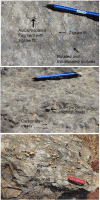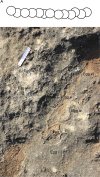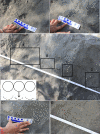New Late Cretaceous titanosaur sauropod dinosaur egg clutches from lower Narmada valley, India: Palaeobiology and taphonomy
- PMID: 36652404
- PMCID: PMC9848018
- DOI: 10.1371/journal.pone.0278242
New Late Cretaceous titanosaur sauropod dinosaur egg clutches from lower Narmada valley, India: Palaeobiology and taphonomy
Abstract
The Upper Cretaceous (Maastrichtian) Lameta Formation is well-known for its osteological and oological remains of sauropods from the eastern and western parts of the Narmada Valley, central India. The newly documented ninety-two titanosaur clutches from Dhar District (Madhya Pradesh State, central India) add further to this extensive data. Previously parataxonomy of these titanosaur clutches was carried out with a few brief reports on palaeobiological and taphonomic aspects. The quantitative data collected from the new clutches (this study) opens avenues to additionally understand more about titanosaur palaeobiology and to qualitatively understand preservation and taphonomical aspects of their egg clutches. Herein, we document 256 eggs and three clutch patterns (viz. circular, combination, linear) that are assignable to six oospecies. The high oospecies diversity points to a possible high diversity in titanosaur taxa in the Indian sub-continent though it is not reflected in titanosaurid body fossils. All the macro- and micro-structures helped in understanding egg deformation and preservation from a taphonomic point of view. Additionally, a pathologic egg documented from the study area helped in understanding the reproductive biology of titanosaurs, such as the possibility of segmented oviduct and sequential laying of eggs by titanosaurs. In addition, we made an attempt to infer aspects such as egg burial, absence of parental care, colonial nesting behavior. All the egg clutches were observed within sandy limestone and calcareous sandstone lithologies that occur in scattered outcrops with rocks showing floating siliciclastic grains in a micritic groundmass. Further, the presence of ferruginous sandstone in the Jamniapura and Padlya regions (Dhar District, central India) is indicative of a possible alluvial/fluvial setting. The presence of grainy intraclastic fabric, alveolar-septal fabrics, brecciation and shrinkage cracks observed in the clutch-bearing rocks are indicative of a low energy-low gradient palustrine depositional condition in a fluvial/alluvial setting. Finally, we envisage that a few egg clutches of this area were laid close to lake/pond margins while most were laid away from the lake/pond margins, and thus, were hatched.
Copyright: © 2023 Dhiman et al. This is an open access article distributed under the terms of the Creative Commons Attribution License, which permits unrestricted use, distribution, and reproduction in any medium, provided the original author and source are credited.
Conflict of interest statement
The authors have declared that no competing interests exist.
Figures

















References
-
- Sahni A, Gupta VJ. Cretaceous egg-shell fragments from the Lameta Formation, Jabalpur, India. Bulletin, Indian Geologists Association. 1982;15(1): 85–88.
-
- Sahni A, Rana RS, Prasad GVR. SEM studies of thin eggshell fragments from the intertrappeans (Cretaceous-Tertiary transition) of Nagpur and Asifabad, peninsular India. Journal of the Palaeontological Society of India. 1984;29: 26–33.
-
- Jain SL, Sahni A. Dinosaurian egg shell fragments from the Lameta Formation at Pisdura, Chandrapur District, Maharashtra. Geoscience journal. 1985;6(2): 211–20.
-
- Srivastava S, Mohabey DM, Sahni A, Pant SC. Upper Cretaceous Dinosaur egg clutches from Khede District (Gujarat, India), their distribution, shell ultrastructure and palaeoecology. Palaeontographica. Abteilung A, Paläozoologie, Stratigraphie. 1986;193(5–6): 219–33.
-
- Vianey-Liaud M, Jain SL, Sahni A. Dinosaur eggshells (Saurischia) from the Late Cretaceous Intertrappean and Lameta Formations (Deccan, India). Journal of Vertebrate Paleontology. 1987;7(4): 408–424.
Publication types
MeSH terms
LinkOut - more resources
Full Text Sources

